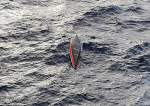Yara
Member
Sadly, a brave adventurer has lost his life at sea after his boat overturned and did not self-right.
Jean-Jacques Savin: French adventurer dies crossing Atlantic Ocean
Looking at his boat design, at a first look, the massive tumblehome says to me that it has poor self-righting ability. Getty images
Getty images

Jean-Jacques Savin: French adventurer dies crossing Atlantic Ocean
Looking at his boat design, at a first look, the massive tumblehome says to me that it has poor self-righting ability.
 Getty images
Getty images

